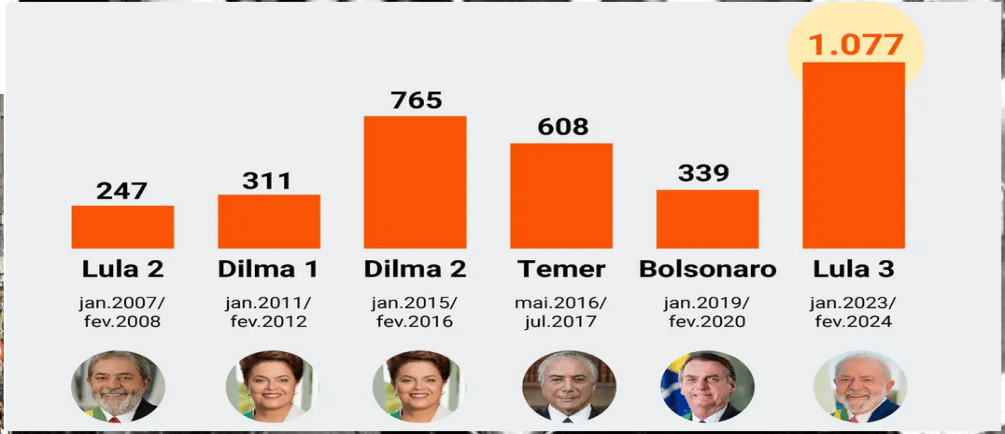Brazil’s Economic Situation: An Investigative Overview
Brazil’s Economic Situation: An Investigative Overview. Brazil’s public debt has shown a concerning upward trend in recent years. In 2024, the Gross Government Debt (DBGG) reached 76.1% of GDP, totaling R$9 trillion.
NEWS
Everton Faustino
4/6/20256 min read


Net debt also rose, hitting 61.1% of GDP, reflecting the impact of nominal interest rates and fiscal deficits. This scenario places Brazil among the most indebted emerging economies, making it harder to attract investments and increasing credit costs.
The Gross Government Debt (DBGG) was inherited by the current administration at historically high levels. By February 2024, DBGG had climbed to 76.1% of GDP, equivalent to R$9 trillion. This increase was driven by high interest rates, currency depreciation, and accumulated fiscal deficits. The previous government faced pandemic-related challenges, which required emergency expenditures and further increased public debt.
Despite attempts to control debt growth, such as spending cuts and fiscal adjustments, the rise in interest rates and inflation contributed to the DBGG’s continued increase. The absence of structural reforms, which could stabilize the debt-to-GDP ratio in the long run, has exacerbated this situation.
Historical Debt Progression
2018: DBGG stood at 75.3% of GDP
2019: Increased to 76.5% of GDP
2020: Pandemic-driven surge to 88.6% of GDP
2021: Slight decrease to 80.3% of GDP
2022: Stabilized at 77.5% of GDP
2023: Increased to 74.4% of GDP
2024: Reached 76.1% of GDP
Although debt levels slightly declined in 2021 and 2022, they remained high, with no consistent reduction in the long term. The subsequent rise until 2024 highlights fiscal management weaknesses.
Brazil’s high debt dependency on interest rates worsens financial pressures. The effect of elevated interest rates (such as the Selic) increases public financing costs, with a significant portion of the budget allocated to interest payments. This reduces available funds to pay off principal debt, creating a vicious cycle of borrowing. The lack of major fiscal reforms, such as tax or pension system restructuring, continues to strain the budget, limiting efforts to reduce debt levels.
Record Tax Revenue
The year 2024 marked the highest tax revenue in Brazil’s history, totaling R$2.65 trillion. This record was fueled by factors such as:
Reinstating PIS/Cofins taxation on fuels
Higher trade taxes due to the U.S. dollar appreciation
New levies on exclusive investment funds and offshore accounts
Despite this historic revenue increase, Brazil’s fiscal challenges and high public debt costs still limit the positive impact of tax collection on national accounts.
Even with rising tax income, Brazil struggles to reduce its debt due to:
High mandatory expenditures, including public sector salaries, pensions, and retirement benefits, which grow annually—often surpassing inflation.
High benchmark interest rates (Selic), which inflate public financing costs. In 2024, interest payments consumed 8.05% of GDP, redirecting much of the revenue toward covering these expenses.
Increased social spending, particularly in healthcare, education, and emergency aid programs, raising overall public expenditure.
Limited control over discretionary spending, contributing to persistent nominal deficits despite revenue gains.
The Cost of Inefficient Spending
Brazil’s high tax revenues have not led to substantial improvements in reducing public debt or fostering economic growth, raising concerns about how effectively the government utilizes its resources. Despite significant expenditures in sectors such as healthcare, education, and infrastructure, the quality and accessibility of public services remain below expectations compared to other nations with similar revenue levels. This points to inefficiencies in resource allocation and flaws in public administration.
Rigid Budget Constraints
A considerable portion of Brazil’s budget is tied to mandatory expenditures, such as pensions and public sector salaries. This limits strategic investments that could drive economic growth. Only a small fraction of the budget is allocated to infrastructure projects, technological innovation, or sustainable development initiatives. Meanwhile, a large share is spent on maintaining government operations, rather than productive investments.
Frequent corruption scandals, procurement fraud, and resource mismanagement further reinforce the perception that public funds are poorly utilized. Bureaucratic inefficiencies slow down administrative processes, increase implementation costs, and reduce the impact of government spending.
Limited Effect of Rising Revenues
Even with record-high tax collection, fiscal and economic challenges remain severe. Structural reforms that prioritize efficiency and results-driven spending would be essential to reversing this trend.
Underinvestment in Growth-Driving Sectors
Although some expenses are necessary, the majority of the budget is not directed toward investments that could stimulate economic expansion, such as infrastructure development. This hampers efforts to generate returns that could ease Brazil’s debt burden.
Debt Surge During the Pandemic
In 2020, the pandemic triggered a sharp rise in Brazil’s Gross Government Debt (DBGG), soaring from 75.3% to 88.6% of GDP. This increase exacerbated existing fiscal challenges, and the slow recovery process underscores Brazil’s vulnerability to financial and economic shocks.
Slow GDP Growth and Fiscal Limitations
Despite occasional GDP recoveries, Brazil’s economic growth has not been strong enough to reduce the debt-to-GDP ratio, limiting the country’s ability to generate larger and consecutive primary surpluses to balance its public accounts.
Several structural issues hinder Brazil’s sustainable economic development, including:
Complex tax system
High production costs
Excessive bureaucracy
Reduced competitiveness
Additionally, Brazil faces a severe fiscal inequality problem. The regressive tax system disproportionately affects small businesses and lower-income consumers, perpetuating economic disparities and limiting overall growth.
Fiscal Deficit: A Persistent Challenge
Brazil’s fiscal deficit remains a critical issue. In 2024, the nominal public sector deficit stood at 8.45% of GDP, totaling R$998 billion. This figure includes public debt interest payments, which accounted for 8.05% of GDP.
Despite efforts to reduce the primary deficit, such as the surplus recorded in December 2024, Brazil’s nominal deficit remains a major challenge. The high benchmark interest rate (Selic) further exacerbates the issue, increasing public debt financing costs.
While Brazil’s GDP grew by 3.4% in 2024, driven by the services and industrial sectors, economic fragility persists. The high debt-to-GDP ratio limits the government’s ability to invest in crucial areas such as infrastructure and education, and economic growth has not been sufficient to offset fiscal deficits and rising public debt.
The Impact of High Interest Rates
Brazil maintains elevated interest rates due to structural and cyclical factors aimed at economic stabilization and inflation control. The benchmark Selic rate serves as the primary tool used by Brazil’s central bank to curb inflation.
Why Brazil’s Interest Rates Remain High:
Inflation control: High interest rates discourage consumer spending and credit, reducing demand and alleviating price pressures.
Attracting foreign investors: Brazilian government bonds become more attractive to international investors, bringing dollars into the country and stabilizing foreign exchange rates—especially during global economic uncertainties.
Managing investor risk perception: Given Brazil’s large public debt, high interest rates help compensate for investor concerns regarding fiscal risks.
Fiscal imbalances: Brazil’s unstable fiscal position forces the central bank to maintain high rates to avoid inflationary spirals.
Inflation-indexed contracts: Many Brazilian financial agreements—such as rent and healthcare plans—are tied to past inflation rates, creating a cycle of automatic price adjustments that demand a more restrictive monetary policy.
Global monetary policies: U.S. Federal Reserve rate hikes and policies from other developed economies affect Brazil’s need to maintain competitive interest rate differentials to prevent capital flight.
Balancing Stabilization and Growth
Although high interest rates help stabilize Brazil’s economy, they also bring negative consequences, such as:
Expensive credit
Reduced consumption
Slower economic expansion
This trade-off between monetary policy and growth remains a central challenge for Brazil’s fiscal health and economic competitiveness.
Future Economic Impacts
Brazil's economic future faces major challenges. The rising public debt trajectory could trigger a confidence crisis among investors, increasing risk premiums and making access to capital more difficult. With limited resources, the government may struggle to implement effective social and economic policies. The urgency for fiscal and tax reforms is critical to balancing public finances and stimulating sustainable growth.
Brazil needs a strong strategy to address these challenges. Fiscal reforms, expenditure control, and economic growth incentives are key to ensuring a more prosperous and sustainable future. The current situation demands immediate attention and action to prevent more severe consequences.
Brazil’s Economic Situation, Brazilian Public Debt, Economic Growth, Fiscal Deficit, High Interest Rates, Tax Complexity, Financial Terms, Gross Government Debt (DBGG), GDP (Gross Domestic Product), Tax Revenue, Tax Reform, Primary Surplus, Selic Rate, Foreign Investments, Economic Impacts, Public Debt Burden, Currency Devaluation, Primary Deficits, Financing Costs, Fiscal Challenges, Misuse of Public Resources, Policies and Reforms, Fiscal Reforms, Efficient Public Management, Infrastructure Investments, Sustainable Growth, Technological Innovation, Economic Sustainability, Structural Issues and Criticisms, Bureaucracy in Brazil, Administrative Inefficiency, Corruption and Fraud, Fiscal Inequality, Regressive Tax System, Government Operational Costs, Relevant Data.
https://www.bcb.gov.br/estatisticas/estatisticasfiscais?form=MG0AV3&form=MG0AV3
https://www.poder360.com.br/poder-economia/rombo-fiscal-atinge-r-1128-trilhao-e-bate-recorde-historico/?form=MG0AV3&form=MG0AV3
https://economia.uol.com.br/noticias/redacao/2025/03/07/pib-2024.htm?form=MG0AV3&form=MG0AV3
https://g1.globo.com/economia/noticia/2024/12/03/entenda-por-que-o-pib-sobe-acima-do-esperado-mas-mesmo-assim-o-pais-precisa-cortar-gastos.ghtml?form=MG0AV3&form=MG0AV3
https://g1.globo.com/economia/noticia/2025/01/14/brasil-tem-um-dos-maiores-deficits-nominais-do-mundo-e-alta-da-divida-deve-se-intensificar-diz-btg.ghtml?form=MG0AV3&form=MG0AV3
https://congressousp.fipecafi.org/anais/19UspInternational/ArtigosDownload/1598.pdf?form=MG0AV3&form=MG0AV3
https://www.scielo.br/j/neco/a/4HrvmyWRDXKVYFnGDxSkBcn/?form=MG0AV3&form=MG0AV3
https://cursos.ufrrj.br/grad/cienciaseconomicas/files/2018/01/67003-Texto-do-Artigo-346723-1-10-20221207.pdf?form=MG0AV3&form=MG0AV3
https://economia.uol.com.br/noticias/redacao/2025/01/28/arrecadacao-2024.htm?form=MG0AV3&form=MG0AV3
https://investnews.com.br/economia/a-bomba-da-divida-americana-e-os-estilhacos-dela-no-brasil/?form=MG0AV3&form=MG0AV3
https://iclnoticias.com.br/economia/divida-dos-estados-unidos-economia-global/?form=MG0AV3&form=MG0AV3
https://www.cnnbrasil.com.br/economia/macroeconomia/calote-da-divida-dos-eua-teria-repercussoes-muito-serias-na-economia-global-diz-fmi/?form=MG0AV3&form=MG0AV3
https://dinheironapratica.com.br/blog/os-impactos-dos-tributos-na-economia-brasileira/?form=MG0AV3&form=MG0AV3
https://www.migalhas.com.br/arquivos/2024/2/9AF3CA3C9296C8_16.OimpactoocultodosTributosno.pdf?form=MG0AV3&form=MG0AV3
https://istoe.com.br/istoegeral/2024/10/28/como-a-reforma-tributaria-afetara-a-economia-e-os-investimentos-no-brasil/?form=MG0AV3&form=MG0AV3
https://www.msn.com/pt-br/dinheiro/economia-e-negocios/entenda-por-que-o-banco-central-elevou-a-selic-a-1425-ao-ano/ar-AA1BjRef?form=MG0AV3&form=MG0AV3
https://www.cnnbrasil.com.br/economia/macroeconomia/entenda-por-que-o-banco-central-elevou-a-selic-a-1425-ao-ano/?form=MG0AV3&form=MG0AV3
https://www.moneytimes.com.br/por-que-as-taxas-de-juros-no-brasil-sao-tao-altas-rnda/?form=MG0AV3&form=MG0AV3
https://www.msn.com/pt-br/dinheiro/economia-e-negocios/a-selic-pode-chegar-a-15-em-2025-entenda-como-proteger-seus-investimentos/ar-AA1BnzVd?form=MG0AV3&form=MG0AV3
